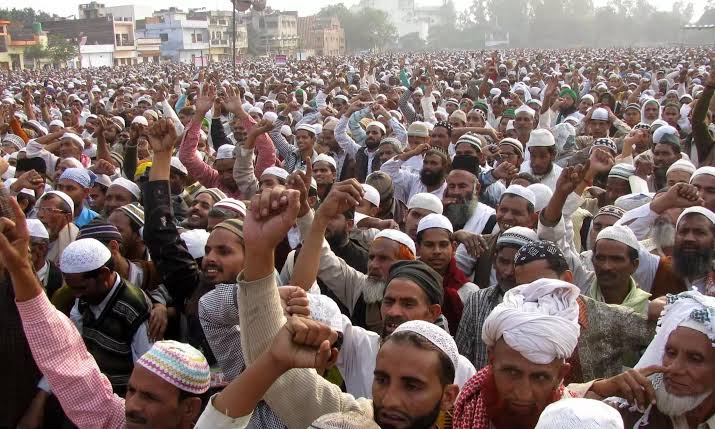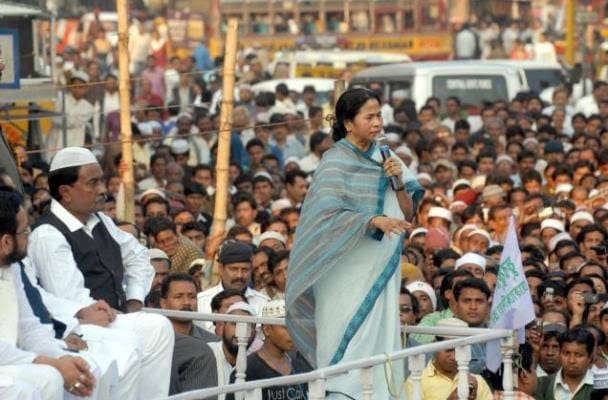
In one of her first public statement after the result of the 2019 general elections in which Bharatiya Janata Party (BJP) registered a speculator success in West Bengal with 18 seats (and 37.4 % votes), West Bengal Chief Minister Mamata Banerjee had noted nonchalantly: “I appease Muslims, no? I will go there (iftar party) a hundred times. Je goru dudh dei tar lathio khete hoi (if a cow gives milk, one has to be prepared for its kicks also).”
Both opposition parties and many Muslim intellectuals criticized her for her use of such words. But ignoring her colloquial jargon, most Muslims also took solace in the fact that here was one chief minister, and the leader of one political party who did not shy from publicly standing by them even in these difficult times, when every other political party and politician is too careful to not be seen as “pro-Muslim” lest they are accused of “Muslim appeasement”.
Those who have followed the rise of the TMC in the state, however, were not as surprised. With 27% population (according to 2011 census – Muslims comprise a sizeable chunk of the electorates, and they played a significant role in her victory in both 2011 and 2016 assembly elections.
In 46 seats, more than 50% of voters are Muslims while in 16 more they are between 40-50 %, besides comprising 20-40 of voters in 83 seats, according to an analysis of the 2016 voters’ list by Sabir Ahamed of the Pratichi Institute.
2011 Assembly Election and Steps Towards Empowering Muslims
Riding high on the Nandigram and Singur protests, Mamata Banerjee who in the past had been an ally of the BJP and was also a part of the AB Vajpayee-led NDA government, tried her best to woo different communities, including Muslims.
In the 2011 manifesto, Trinamool Congress had promised, in particular, “Muslim universities and colleges… more madrasas and Urdu schools…implement the recommendations of the Sanchar Committee and the Ranganathan Commission, where 10% Urdu speaking Muslims are there…set aside a portion of the State’s Budget for plans intended for the educational and economic upliftment of Muslims…Give, without any hindrance, official recognitions to Urdu educational institutions, thereby facilitating them all the constitutional benefits which they lacked off hitherto. Special budgetary provisions should be made for imparting technical education in Madrasas.
It must be noted here that the publication of the 2006 Sachar Committee Report that pointed to the backwardness of Muslims in the state had led to a new kind of awakening among Muslims in Bengal who became more assertive than ever regarding their rights. Disenchanted with the Left Front Government, Muslims – like several others – decided to have a “poriborton (change)” in 2011 when they voted in large number in favor of TMC, particularly in South Bengal (in north Bengal, Congress had still maintained a steady share of votes).
2011 consequently witnessed for the first time more than 50 Muslims elected representatives in the state – 59, to be more precise (13 more than 2006). TMC had given tickets to 38 candidates and 25 of them had won.
TMC is often accused of facilitating the spread of the BJP in the state, what many miss, however, is that the Mamata Banerjee-led government also for the first time provided political space in the state politics to Muslims as they are, without any pretensions or expectations of hiding their identity.
Banerjee kept the additional portfolio of Minority Affairs and Madrasah Education (MAME) with herself, and took several affirmative steps, from giving scholarships and educational and soft loans to setting up hostels in district headquarters, building new Hajj House, and extending generous fund to newly established Aliah University. Her government has expanded the list of OBC, practically covering 97 % of Bengali Muslims which has marginally improved the employment in government services in the last decade.
After decades of the Left Front government whose ministers avoided any religious function, Mamata Banerjee visited Eid congregations, attended iftar parties, etc. as enthusiastically she attended Durga Puja, or any other festival of different faiths.
This, however, backfired as opposition parties – not just BJP, but even Left – as well several civil society members in the state-capital accused her of pandering to Muslims, particularly pointing to some of her populist steps like remunerations of imams and muezzins by the State Auqaf Board or her outreach to clerics like Maulana Barkati of Tipu Sultan.


2016 Assembly Election and Afterwards
Unfazed by criticism, she continued with her outreach to community leaders like Pirzada Toha Siddiqui of Furfura Sharif, and later also Siddiqullah Chowdhury, state president of Jamiat-e-Ulama Hind, who contested the 2016 election on TMC ticket and became a minister during her second tenure.
In fact, in 2016 TMC fielded 57 Muslims (19 more than 2011) out of whom 32 won the elections. Consequently, while the number of Muslim MLAs remained 59 but TMC improved its tally.
But as the 2019 election approached, Banerjee became more guarded in her approach as the depleting opposition space earlier occupied by the Left Front and Congress was hijacked by the BJP. Although she still attended the Eid prayers (in 2020 owing to the pandemic, Eid congregations did not take place), she was seen less and less in Muslim gatherings or made fewer public announcements of their support.
It was not that MAME or West Bengal Minority Finance Corporation stopped working, but they were cautioned and avoided over-the-top publicity. For example, while earlier she would inaugurate the Milan Utsav organized by MAME at Park Circus Maidan, she has avoided the fare for the last three consecutive years. Except, Urban Development Minister Firhad Hakim, she is hardly seen in the company of many Muslim leaders of even her party these days.
The statement regarding happily getting few kicks of the cow as she gets to milk her was made after the 2019 elections, but once Prashant Kishor led I-PAC took over her election-strategy, TMC supremo appears even more careful although she enthusiastically led the anti-CAA protests in the state.
Manifesto of 2021 vs 2016
A comparative analysis of the 2016 and 2021 manifestos by Sabir Ahamed throws some interesting results. The 2016 manifesto had the word minority 41 times and Muslims twice, while in contrast in 2021, the word Muslim has not been used even once while minority appears twice – both times clubbed along with other communities.
Page 5 – And I promise that Bengal will continue to lead in – economy, industry, women empowerment, job creation, and welfare of minority, backward classes, SC/ST communities, covering each and every individual of the state in the next five years.
Page 26 – Minority youths & members of Self-Help Groups (SHGs) have been provided with 9.43 lakh Term Loans and Micro Credit to create sustainable employment during 2011-20.
Interestingly, they do not even figure in section-two of the manifesto titled, “Social Justice & Security”. The TMC manifesto also lists some of the “achievements” in different categories. Interestingly, it is silent on an otherwise decent performance of the MAME as well.
2021 Assembly Election and What it Means for Muslims
TMC has fielded 46 Muslim candidates this time (intriguingly WB CM said 42 in her press conference), 11 less than the last time, but still 8 more than the 2011 figure of 38. Mamata Banerjee is hoping to come back to power for the third consecutive term, and that would only be possible if TMC can secure at least 70-80 percent of Muslims’ votes.
But the 2021 manifesto – and her recent public addresses – seem to be focussing on wooing back the SC/ST votes, particularly Namsudras, and other backward Hindu communities. As there were fears that thee excessive focus on Bengali sub-nationalism can alienate the Hindi speaking people, she held a special meeting with them in the month of January.
Even in the past, Banerjee evoked Hindu chants and Islamic slogans (as also those of other faiths) – she did something similar on 19 March in East Medinipur. But her emphasis on her Brahmin identity (like Rahul or Priyanka Gandhi earlier), and recitation of Chandi-path at Nandigram, also imply that like Gujarat or UP, secular parties are trying to woo them back.
These are only fair as these communities had voted in large numbers for the BJP in the 2019 Lok Sabha elections, and TMC understandably wants to win at least some of them back. But if opinion polls and field reports are to be believed it appears a herculean task.
With the emergence of the BJP as the most important opposition force in the state, the political debate in Bengal – like the rest of India – has taken a certain rightward turn. This majoritarian politics has led to simultaneous invisibilisation of Muslims in political and public space, as liberal political parties expect them to not become very assertive or demanding; remain passive and largely in the background in political space; but continue voting for them with the hope that the “fascist and communal BJP” can be kept at bay.
Interestingly, it was the TMC that facilitated the rise of identity-based politics in the state and helped in the growth of a new middle class of Bengali-speaking Muslims in particular. But now that many young Muslims became more assertive, and demanded their rights and equitable share in representations and resources, they tried to either silence them or discredit them. This is where rookie politician Pirzada Abbas Siddiqui, whose Indian Secular Front has allied with the Left Front and Congress got initial support.
But even a Siddiqui has to be clear to not become “another Owaisi” and “mainstream” his politics. He does not talk about Muslims alone anymore, but about “all marginalised people, including poor Brahmins” and has to give almost half of his allotted tickets to non-Muslims.
In all likelihood – if opinion polls are to be believed – TMC will form the government for the third consecutive term, and will manage to get the majority of Muslims’ votes in the state as Banerjee remains a popular leader and she is still the best-bet yet in the state. Some of her welfare schemes like Kanya Shri, Sabuj Sathi, free ration, and most recently Swasthya Sathi have benefited every poor and needy.
No doubt, much needs to be done as the general socio-economic conditions of Muslims in the state have not improved substantially still, but sadly an otherwise commendable manifesto that talks of universal basic income is completely silent on the issues of minorities lest they further alienate Hindus away from the party. But when there is “fear” of “butcher” coming, can cows dare kick – or ask questions – before giving milk?
M Reyaz teaches journalism at Aliah University, Kolkata, and is a political commentator. He tweets at @journalistreyaz.



